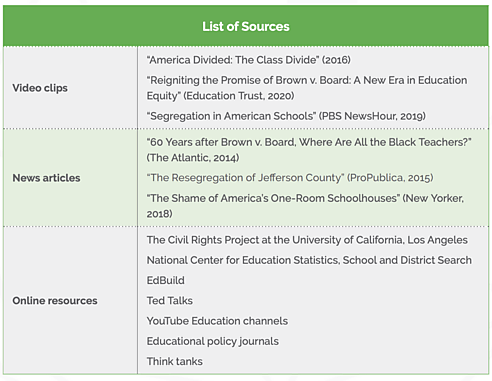Lesson Objectives
- Understand the historical context of Brown v. Board of Education.
- Examine the ongoing impact of Brown v. Board on education and society in the United States.
The media the students will be talking about should be on display as the students walk in. This media should be easy to interpret but also have layers of meaning that encompass what rights were won and worth fighting for in terms of Brown v. Board. Examples: “The Problem We All Live With” by Norman Rockwell or any image that can be found when searching online for “Brown v. Board.”
Journal prompt: What does this image mean to you? How does it relate to the civil rights movement? How does it relate to civil rights today?
Students need to know and understand what led to the Brown v. Board decision. You can do this any number of ways, but a living timeline shows students all that happened before the Civil War up until the decision in 1954. Look at the rulings that can be found at the National Archives (“Timeline of Events Leading to the Brown v. Board of Education Decision of 1954”).
Give pairs and/or small groups of students a piece of chart paper, one of the events from the archive, and time to research the event.
Reflection: What do you notice about the events? What are the causes and effects? What is the timeline of the events?
These questions can be used at the end of class to bring the topics of today’s lessons together:
Review of Brown v. Board
Journal prompt: What is Brown v. Board, and how did it shape the United States?
Discuss the major components of what led to the decision. Have students make inferences about what the decision is and what it did for the United States based on the activities from the previous class period.
Please make sure that the posters from the previous class period are still up for the students to look at and read.
Have students read the Brown v. Board ruling transcript in pairs or small groups. Instead of dividing it up for them, let the groups decide how they will read the transcript. Give a copy of the transcript to each person to read and look over. Give each pair or group time to read and mark up the text. They should look at the transcript in terms of the following:
Share with students the modern‐day challenges to Brown v. Board. Look at the list below for videos, images, and articles that suit you, your classroom, and your district.

These questions can be used at the end of class to bring the topics of today’s lessons together:
CCSS.ELA-LITERACY.WHST.11–12.8: Gather relevant information from multiple authoritative print and digital sources
CCSS.ELA-LITERACY.RH.11–12.9: Integrate information from diverse sources, both primary and secondary, into a coherent understanding of an idea or event.
CCSS.ELA-LITERACY.WHST.11–12.7: Conduct short as well as more sustained research projects.